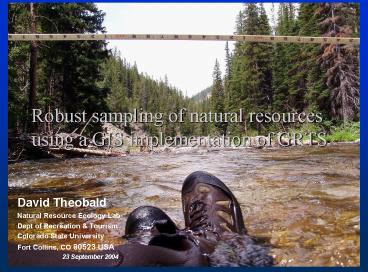Robust sampling of natural resources using a GIS implementation of GRTS - PowerPoint PPT Presentation
1 / 27
Title:
Robust sampling of natural resources using a GIS implementation of GRTS
Description:
Robust sampling of natural resources using a GIS implementation of GRTS David Theobald Natural Resource Ecology Lab Dept of Recreation & Tourism – PowerPoint PPT presentation
Number of Views:84
Avg rating:3.0/5.0
Title: Robust sampling of natural resources using a GIS implementation of GRTS
1
Robust sampling of natural resources using a GIS
implementation of GRTS
- David Theobald
- Natural Resource Ecology Lab
- Dept of Recreation Tourism
- Colorado State University
- Fort Collins, CO 80523 USA
- 23 September 2004
2
Funding/Disclaimer
- The work reported here was developed under the
STAR Research Assistance Agreement CR-829095
awarded by the U.S. Environmental Protection
Agency (EPA) to Colorado State University. This
presentation has not been formally reviewed by
EPA. The views expressed here are solely those
of the presenter and STARMAP, the Program (s)he
represents. EPA does not endorse any products or
commercial services mentioned in this
presentation.
3
Practical sampling needs
- Most information for least cost
- Sample some areas with higher probability than
others - Some features are more important than others
- Higher uncertainty of knowing about particular
situations - Some locations are more difficult (time, ) to
access than others - Flexibility
- In-the-field decisions (e.g., access denied,
extra time) - Changes in funding ( or -) for current project
- Subsequent projects (additional funding) augment
existing dataset (but often different study area) - GRTS algorithm (Stevens 1997 Stevens and Olsen
1999 Stevens and Olsen 2004)
4
Why GIS framework?
- Spatial data is needed to as input to describe
population (frame) - Spatial data used to describe strata, to describe
inclusion probabilities, including continuous
variables (e.g., terrain) - Ability to sample point, line, and area-based
ecological resources - Flexibility in adjusting input to alter sampling
design - Visualize sampling design in relation to other
geographic data (e.g., accessibility, ownership) - Large, broad user base of GIS technology
5
Existing GIS-based sampling
- Sampling in ArcView v3, ArcGIS v8, v9
- Typically simple random sampling (e.g., random x,
y constrained to polygon of study area) - GStat (www.gstat.org) Pebesma and Wesseling.
1998. Gstat, a program for geostatistical
modeling, prediction and simulation. Computers
and Geosciences 24(1)17-31. - Traditional stratified, simple random sampling
- r.le tools for GRASS
- Stratified sampling
6
Ecological resource types
- Areas (e.g., lakes, land cover patches)
- Discrete represent as point shapefile, GRID
with single cell - Convert to centroid or labelpoint then to GRID
- Tesselate surface e.g., watersheds, 8-digit HUCs
- Discontinuous all lakes in Oregon
- Continuous represent as polygon, GRID as zones
- Patches of vegetation types
- Variation of water clarity within selected lakes
- Estuarine resources
- Area bias?
- Lines (e.g., streams, roads)
- Discrete represent as point shapefile, GRID
with single cell - Individual stream reaches
- 100 segments
- Continuous
- All possible locations on stream network
- Points (e.g., individual trees, lakes)
- Discrete
- all lakes in Oregon
7
Sample
8
Sample
9
Processing steps
- 1. Input
- raster or GRID of frame, inclusion probabilities
- get spatial extent, grain (resolution), study
area (inside, outside, holes) - 2. compute number of quad-levels, L
- 3. generate random permuted 1-4 labels at each L
- 4. add levels together to create reverse-ordered
address - 5. compute sequential list order
- 6. threshold against inclusion probabilities
- 7. convert raster to point shapefile
10
Level 1
3
1
2
4
11
Level 2
1
1
3
3
4
2
2
4
1
1
3
3
2
4
4
2
12
Level 3
13
Morton address to sequential list
14
Reverse-Morton address to list
15
Random permutation of quad values
16
Area frame for vegetation survey
17
Continuous listing of sequential points
18
Laramie Foothills vegetation survey
19
(No Transcript)
20
Summary
- Flexibility of input data point, line, area
- Continuous (gradients) and discrete (strata)
inclusion probabilities - Visualization of sample design
- Can modify inclusion probability based on
accessibility constraints - Develop map of inferred population
- ArcGIS tool
21
(No Transcript)
22
(No Transcript)
23
(No Transcript)
24
Distribution plans
- Currently alpha test phase
- Beta testing January 2005
- Release Spring/Summer 2005
25
- Thanks!
- Comments? Questions?
- STARMAP www.stat.colostate.edu/nsu/starmap
- GIS-GRTS tools in ArcGIS email
davet_at_nrel.colostate.edu
Funding/Disclaimer The work reported here was
developed under the STAR Research Assistance
Agreement CR-829095 awarded by the U.S.
Environmental Protection Agency (EPA) to Colorado
State University. This presentation has not been
formally reviewed by EPA. The views expressed
here are solely those of the presenter and
STARMAP, the Program (s)he represents. EPA does
not endorse any products or commercial services
mentioned in this presentation.
Funding/Disclaimer The work reported here was
developed under the STAR Research Assistance
Agreement CR-829095 awarded by the U.S.
Environmental Protection Agency (EPA) to Colorado
State University. This presentation has not been
formally reviewed by EPA. The views expressed
here are solely those of the presenter and
STARMAP, the Program (s)he represents. EPA does
not endorse any products or commercial services
mentioned in this presentation.
Funding/Disclaimer The work reported here was
developed under the STAR Research Assistance
Agreement CR-829095 awarded by the U.S.
Environmental Protection Agency (EPA) to Colorado
State University. This presentation has not been
formally reviewed by EPA. The views expressed
here are solely those of the presenter and
STARMAP, the Program (s)he represents. EPA does
not endorse any products or commercial services
mentioned in this presentation.
CR - 829095
CR - 829095
CR - 829095
26
Stream frame
27
(No Transcript)































